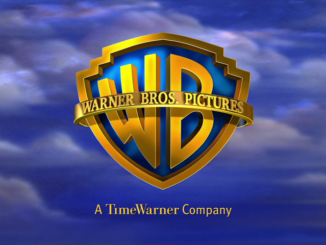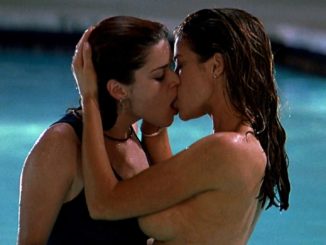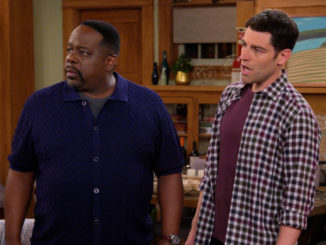
Tyler Perry’s Madea character is a gun-toting, crude caricature of a “strong” (or maniacal) black woman. While we denounce films where black males settle their differences with guns, the media embraces this negativity wholeheartedly. What is the difference between the image presented by O-Dog in “Menace To Society” (played by Larenz tate) and Madea? How much positivity can be drawn from a black man dressed as a loud talking, gun-toting, short-tempered woman?
The common thread among “Perryites” is that they find a message in his works, but most people who watch his movie–young folks in particular–aren’t seeking a message. Like most filmgoers they seek two hours of something that draws them away from reality; amusement. The imagery is particularly bad if it portrays black men as weak and subservient, contradicting the traditional male model.
Non-threatening black images have been a Hollywood staple since the days of Bert Williams, Stepin Fetchit and Eddie “Rochester” Brown. That trend has continued onward and we have enough JJ’s, Reruns, Grady Wilsons and Anthony Bouviers (Meshach Taylor’s character on “Designing Women”) to prove it. This is why books, movies, CDs, etc. that bash black men are such big sellers. In that regard, Mr. Perry pales in comparison to the queen of the MISTERsogynists, Terri “My-man-caused-blues-are-yo-man-caused-blues” McMillan.
Blacks who confront racism head, even in a comedic vein like Martin Lawrence, Chris Rock, Dave Chappelle, wind up beat down by the same system that first propped them up. When is the last time you saw a Hughes Brother film getting major play in the media? Why is Spike Lee now making “safe” films? One of Mr. Lee’s films, “Bamboozled” was less product than prophecy, and all it takes is a look at the dearth of quality black films coming out of Hollywood. to see that decision makers in Hollywood see most blacks as buffoons.
Recently black thespians Denzel Washington, Morgan Freeman, Jamie Foxx and Halle Berry have won Oscars. Furthermore, in recent years we have seen a spate of fine afrocentric films–“Ray”, “Antwone Fisher”, “Rwanda,” Lackawanna Blues” and “Drumline” to name a few. But for every one of those films there is a “Soul Plane”, “Pootie Tang”, “White Chicks” or a Tyler Perry creation–multiplied by three.
Why is there such a dearth of innovative black filmmaking? Where is the political satire (as in “Undercover brother”)? The believable love stories (as in the surprisingly good “Deliver Us From Eva”)? Where are the relevant bio-pics–such as The Jackie Robinson story, or a film detailing the lives of Frederick Douglas and Robert F. Williams?
Spike Lee attempts to answer that question, stating “The one way to change everything is to get Black people into those gate keeper positions (where they have the power to green light films). That’s how you change things, not with Academy Awards.”
The losers in this game are young black people, who are spoon-fed negative images of self under the guise of “comedy.” Meanwhile, films that attempt to elevate the level of consciousness (“Once Upon A Time When We Were Colored”, “Rwanda”, “Bamboozled” et al.) are poorly promoted, shown outside of the black community and largely ignored. This, in my view, is no coincidence. As long as the producers of these films don’t look, think or live like us, all we can expect to see from them is their twisted take of black life.
The sad and simple reality is that the black cinematic works being greenlighted for wide release usually portray blacks as clowns, drug dealers or gangsters. Blacks are a significant portion of the movie audience, and this is supported by the fact that three black films released in 2006 have finished number one at the box office during their first week of release. (“Inside Man,” “Madea’s Family Reunion” and “Big Momma’s House 2.”
Gitesh Pandya, editor of BoxOfficeGuru.com believes, “There is a six-week period where there is a lot of attention on African-American stories. The studios have figured out that this is a nice time of year to serve what is often times an underserved audience.” (Greg Hernandez, Los Angeles Daily News, April 14, 2006).
Hollywood Fascinated By Race
Recently I viewed the 1999 flick, “Whiteboyz” on HBO. It is a satirical, yet all-too real film about a white kid from Iowa who goes by the moniker Flip Dogg, and who glamorizes everything “black,” or at least his perception thereof. (Flip is played by the co-writer of the film, Danny Hoch). When Flip’s black friend Khalid tells him he isn’t black, Flip replies “I’m black on the inside…black is the dope s–t.” It takes a brutal reality check and the death of an innocent man before this kid is jarred back to his vanilla reality. Later that evening I caught Robert Benton’s, “The Human Stain.” Both films dealt with racial denial and the shame and self-hatred felt by many light-skinned blacks, But such introspective and informative perspectives on race are sore lacking in Hollywood, with one notable exception: “Crash,” which earned the 2006 Oscar for Best Picture. It too had race as the central theme. However, Hollywood relegates most films detailing the serious side of black life to the straight-to-video bin. Instead of “Lackawanna Blues” (Terrence Howard, Mos Def, S. Epatha Merkerson) getting major play, we get force-fed movies loaded with caricatures, such as “Madea’s Family Reunion.”
Hollywood sometimes confronts the issue of race, but usually that take is not realistic and oftentimes downright laughable (The 1995 John Travolta, Harry Belafonte film “White Man’s Burden” comes to mind). When it comes to black and white, why can’t we see more films like 1970s “The Landlord” (Beau Bridges and Diana Sands)? Instead we get Joe Pesci in “The Super” (1991), a film so laden with stereotypes its unwatchable.
Hollywood’s Dearth of Originality
I lament Hollywood’s moving from “storytelling” to “action sequencing”. Today’s movies stink for a variety of reasons, but one is what I call “The Piggyback Principle”: More commonly referred to as “monkey-see-monkey-do.” This is seen in the plethora of films with a similar theme (for example, the teen romance genre), or in the form of lame-brained sequels. This holds true for black “comedies” like “Soul Plane.”
Films today fail to let the camera tell the story, but rely too heavily on special F/X and gratuitous nudity.
As filmgoers, black and white patrons need to send a message. We are weary of Hollywood foisting mindless, unfunny racist comedies and unrealistic portrayals of black life. We demand realism, respect and less of the mind-rotting schlock being passed off today as “art.”
Proudly WWW.PONIREVO.COM



